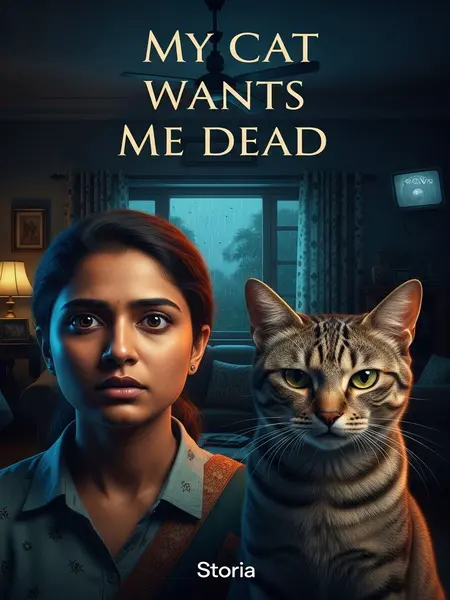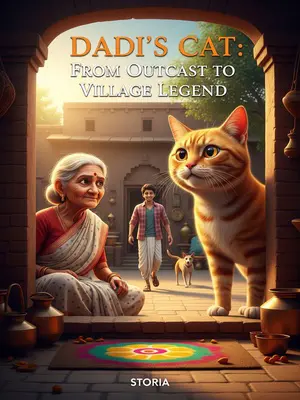Chapter 2: Should I Get Rid of It?
Should I get rid of it?
I sat at my desk, troubled, my thoughts chasing each other like stray dogs in the monsoon.
Above, the ceiling fan made a soft tik-tik sound while my colleagues argued about who’d bring samosas next time. I sipped my watery tea, trying not to look like I had a secret.
Honestly, I’d sensed for a while that there was something not quite right about my cat. It wasn’t like the kittens you see on Instagram Reels. Cute, sure, but those eyes—there was a cunning in them, a ferocity you can’t just brush away. It’s a cat, after all.
Even Aunty Fatima’s Persian, ‘Badshah’, is all fluff and purring. But mine? Even sitting quietly, it gives off don vibes. Sometimes I joke that maybe in its past life, it was a small-time goonda from Andheri.
Other people’s kittens, when they’re happy, rub up against their owners. That’s how they mark their territory—like telling every other billi in the colony, “Ye aadmi mera hai, samjha?”
You know, just like when all the cats at the colony park rub against the gate, stamping their authority. Typical desi behavior.
But my cat? Bilkul alag.
No meowing or headbutting. Mostly, it just watches—like a serial villain who only smirks. Sometimes it comes close, but mostly, it acts as if all this drama is beneath it.
It does rub against me, but only when I’m asleep. It’ll nudge me, check if I’m still, and then slowly press its body against mine, inch by inch, like it’s measuring me.
A couple of times, I’ve woken up in the middle of the night, half in a dream, and found it pressed up against me, tail twitching. As if it’s checking if I’m big enough for… something. In the morning, it’s gone—just a few stray hairs and the faint smell of Whiskas left behind.
Whenever it realises it’s grown a bit, it seems even more excited, like it’s waiting to grow up and finally… well, finish me off.
Honestly, sometimes its eyes gleam with ambition—just like those political netas on TV debates, biding their time to strike.
Its gaze is different from other kittens. When I’m watching, it acts all cute and silly. But the moment I look away, its eyes always find my throat, my groin—those weak spots. Just like a cheetah in those National Geographic shows, eyeing its prey.
I swear, once I caught it staring at my Adam’s apple so intently, I put on a scarf—even though it was May and the current was gone. Amma laughed and called me pagal. 'Pagal ho gaya hai kya? Billi pe itna shak karta hai.'
That’s when it hit me: cats are just smaller versions of lions and tigers. In wildlife shows, they always say, ‘yeh dekhiye, sherni apne shikaar par nazar rakhe hue hai’. My cat does the same—just on a smaller scale, and I’m the unlucky shikaar.
But do I really have to throw it out?
The thought made my chest tight, like I’d just climbed four floors in the heat. Not an easy decision, however many evil plans my cat might be hatching.
After all, I’ve raised it for two years. Aside from the drawing pin incident, it hasn’t actually hurt me.
Barring the odd scratch when I’m late with its food, it hasn’t drawn blood. Honestly, who hasn’t been scratched by a moody billi?
I confided in my old classmate Rohan, who studied animal science—the kind of guy who brings weird snacks to reunions and once tried to feed us mealworms.
After a thoughtful pause, he asked, “Do you think cats and dogs are the same?”
We were at Café Madras, with Rohan dunking a piece of buttered pav into his coffee before launching into his theory, looking like he was about to start a TED talk.
The question stumped me, but I shrugged. “Aren’t they both pets? If you really want to nitpick, one’s a cat and one’s a dog.”
“Arrey yaar, that’s bakwaas. Let me tell you, cats and dogs are fundamentally different.”
He waved his hand, dismissing my ignorance just like my maths teacher used to.
He explained, “The biggest difference is domestication. Dogs? Properly tamed. Cats? Not really. So yes, your cat could actually try to kill you.”
Rohan sipped his coffee and leaned in, lowering his voice as if the walls had ears.
“You can tell how domesticated an animal is by comparing wild and tame versions. Wild dogs and domestic dogs are totally different, but wild cats and house cats—same to same. Dogs are bred to be human companions, aggression toned down. Cats? Still hunters. That’s why your house cat still catches mice. Even if a dog catches a mouse, it won’t eat it—a cat will. That’s the wild in their bones.”
He drew imaginary diagrams with his spoon. “And in villages, stray dogs form packs and get attached to people. Stray cats? They do their own thing, always.”
“So for a dog, humans are masters. For a cat, you’re just another animal in its world. If food runs out, your cat might kill you to survive. Or, if it feels justified, it might decide to kill you for… raising it.”
He gave me a look, as if telling a ghost story from Doordarshan days. “Imagine, beta—you lock up a wild animal, pamper it, but in its mind, you’re the jailor.”
“To us, we’re just raising a cat and being nice. But to a wild feline, it’s imprisonment.”
Rohan spread his hands. “You say your cat wants to kill you? Not shocking. Could happen with any billi.”
His words echoed with the background score of a suspense thriller. I shivered.
I asked what to do. Rohan got serious: “Blindfold the cat, block its ears, take it far away from your house. Most important—erase every trace of its scent. Otherwise, beta, you really might end up as its meal.”
He sounded like he was giving me a secret agent briefing. I imagined cycling through the lanes at midnight, a meowing bundle in my bag.










